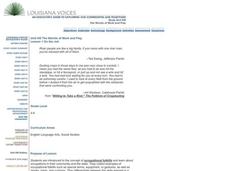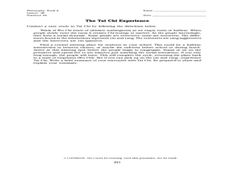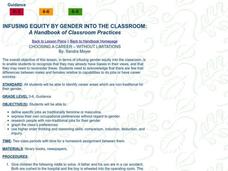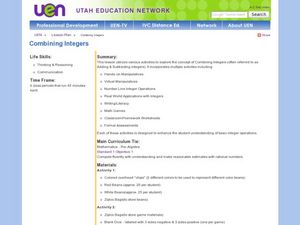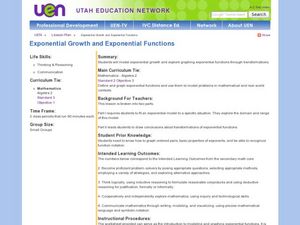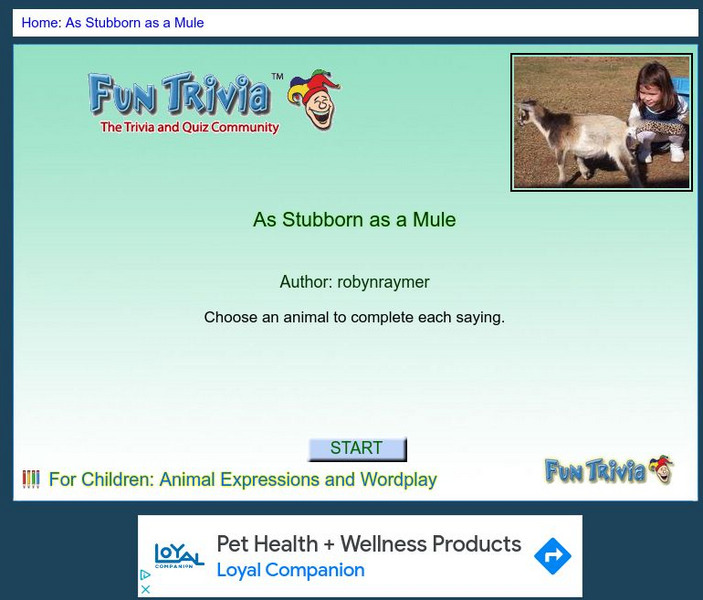Curated OER
The Gingerbread Person
Students discuss gender bias and stereotyping. In this social science lesson, students read the book "The Gingerbread Boy" and discuss why it is a boy. Students then write their own story changing it to a gingerbread girl and a female fox.
Curated OER
On the Job
Learners identify the concept of occupational folklife and learn about occupations in their community and the state. Then they collect examples of occupational folklife such as special terms, equipment, or gestures, as well as stories,...
Curated OER
Tai Chi
Students explore the concept of yin and yang. In this Tai Chi lesson plan, students create a working definition of yin and yang as they read about its role in Eastern philosophy. Students also discuss the relationship between opposites.
Curated OER
CHOOSING A CAREER - WITHOUT LIMITATIONS
Students identify career areas that are not traditional for their gender.
Curated OER
Amazon Rainforest
Seventh graders complete a simulation in which they travel through the Amazon rainforest. Using their map skills, they determine the best route and where to see specific plants and animals. They develop their own database to organize...
Curated OER
The Cycle of Life
Eighth graders search for rites of passage in their own lives and study rites of other cultural groups in Louisiana and around the world. They assess how to recognize moments of importance in people's lives and find meaning in the stages...
Utah Education Network (UEN)
It's All Just Similar to Me
Middle schoolers explore the concept of similar figures. In this similar figures lesson, pupils calculate scale factors of similar triangles. They find missing sides of triangles, and measure angles using protractors and measure sides of...
Curated OER
Putting Your Best Foot Forward
Third graders measure their feet and their parents' feet, record data on computer-generated graphs, and calculate and record mean, median, and mode.
Curated OER
Representing Rational Numbers
Seventh graders explore rational numbers. In this fractions, decimals, and percents instructional activity, 7th graders identify and compare equivalencies between fractions, decimals, and percents. Students use hands-on activities to...
Curated OER
Combining Integers
Seventh graders explore the concept of adding and subtracting integers. In this adding and subtracting integers lesson, 7th graders use white and red beans to demonstrate adding and subtracting integers. Students play an on-line game...
Curated OER
Exponential Growth and Exponential Functions
Pupils explore the concept of exponential functions. In this exponential functions lesson, students model exponential growth about a high school population using an applet. Pupils manipulate the applet to show the effect that a change in...
Curated OER
SAT Reading Comprehension Practice Test 01
In this SAT reading comprehension worksheet, students read an excerpt from a book and answer comprehension questions. Students answer 7 questions and submit their answers in this SAT practice worksheet.
Curated OER
Angle Attributes and Measures
Seventh graders explore the concept of angles. In this angles lesson, 7th graders use protractors to measure angles. Students sing an angle song. Students discuss attributes of angles using a two-color plate manipulative.
Texas A&M University
Wtamu Virtual Math Lab: Beginning Algebra: Reasoning Skills
A tutorial on reasoning skills focusing on both inductive and deductive reasoning. Has several examples and exercises with answers and discussion.
Biology 4 kids
Biology4 Kids: Logical Reasoning
Learn how logic and reasoning play a part in everyday thinking, and how deductive and inductive reasoning leads investigators to conclusions.
Web Center for Social Research Methods
Research Methods Knowledge Base: Deduction and Induction
This site provides a good explanation of deductive and inductive thinking.
University of Utah
University of Utah: History of Psychology: More on Logic
Brief overview of the definitions of 'inductive' versus 'deductive' reasoning.
Lumen Learning
Lumen: Critical Reading: Logic and Structure
This instructional activity focuses on structure and logic including types and purposes of essays, organizational patterns, argumentative writing, and logic and fallacies.
Lumen Learning
Lumen: Boundless Biology: The Science of Biology
Explore the concept of scientific reasoning, and compare and contrast hypothesis and theories while understanding the difference between deductive and inductive thinking.
Science Struck
Science Struck: Examples of Deductive Reasoning
Learn what deductive reasoning is and look at examples of how to apply it.
Other
Fagler College/nas 111/scientific Methodology
Power Point presentation on scientific method for NAS 102 Human and Environmental Biology II.
Fun Trivia
Fun Trivia: As Stubborn as a Mule
This 10-question game requires students to select an animal to complete a saying. Students are directed to double click their answer which brings up the correct answer and an explanation of the saying.
Quia
Quia: Analogy Battleship
This game will increase the player's understanding of different types of analogies. It has three difficulty levels.



